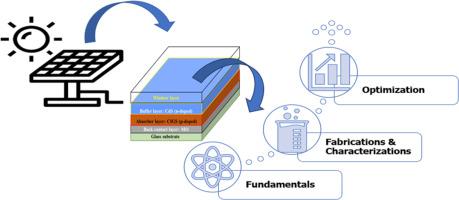Chronological progress in enhancing CIGS solar cell performance through window layer development: Fundamentals, synthesis, optimization
IF 8.3
2区 材料科学
Q1 MATERIALS SCIENCE, MULTIDISCIPLINARY
引用次数: 0
Abstract
Several factors, particularly the material of the window layer, contribute to the efficiency of CIGS solar cells. To optimize light absorption and reduce energy losses, it is critical to select the appropriate material for the window layer development. Thus, the main emphasis of this review is on the development of window layers, covering fundamental concepts, synthesis techniques, characterization methods, and optimization strategies. Metal oxides and doped metal oxides are critical materials for optimizing charge carrier flow, minimizing energy loss, and elevating sunlight transmission to the CIGS absorber. Despite tremendous progress, difficulties such as increased conductivity, transparency, stability, and cost-effectiveness remain. Discovering novel materials, specific combinations, and improved deposition techniques offers further details on the structure-property relationships of window layers. Addressing these difficulties is critical to improving the performance of CIGS solar cells, which are now approximately 23.6 % efficient. These enhancements are critical for progressing sustainable energy solutions.

通过窗口层开发提高 CIGS 太阳能电池性能的时序进展:基础、合成、优化
有几个因素,特别是窗口层的材料,会影响 CIGS 太阳能电池的效率。为了优化光吸收并减少能量损失,选择合适的材料开发窗口层至关重要。因此,本综述的重点是窗口层的开发,涵盖基本概念、合成技术、表征方法和优化策略。金属氧化物和掺杂金属氧化物是优化电荷载流子流动、减少能量损失和提高太阳光对 CIGS 吸收体传输的关键材料。尽管取得了巨大进步,但在提高导电性、透明度、稳定性和成本效益等方面仍然存在困难。新型材料、特定组合和改进沉积技术的发现为窗口层的结构-性能关系提供了更多细节。解决这些难题对于提高 CIGS 太阳能电池的性能至关重要,目前 CIGS 太阳能电池的效率约为 23.6%。这些改进对于推进可持续能源解决方案至关重要。
本文章由计算机程序翻译,如有差异,请以英文原文为准。
求助全文
约1分钟内获得全文
求助全文
来源期刊

ACS Applied Materials & Interfaces
工程技术-材料科学:综合
CiteScore
16.00
自引率
6.30%
发文量
4978
审稿时长
1.8 months
期刊介绍:
ACS Applied Materials & Interfaces is a leading interdisciplinary journal that brings together chemists, engineers, physicists, and biologists to explore the development and utilization of newly-discovered materials and interfacial processes for specific applications. Our journal has experienced remarkable growth since its establishment in 2009, both in terms of the number of articles published and the impact of the research showcased. We are proud to foster a truly global community, with the majority of published articles originating from outside the United States, reflecting the rapid growth of applied research worldwide.
 求助内容:
求助内容: 应助结果提醒方式:
应助结果提醒方式:


